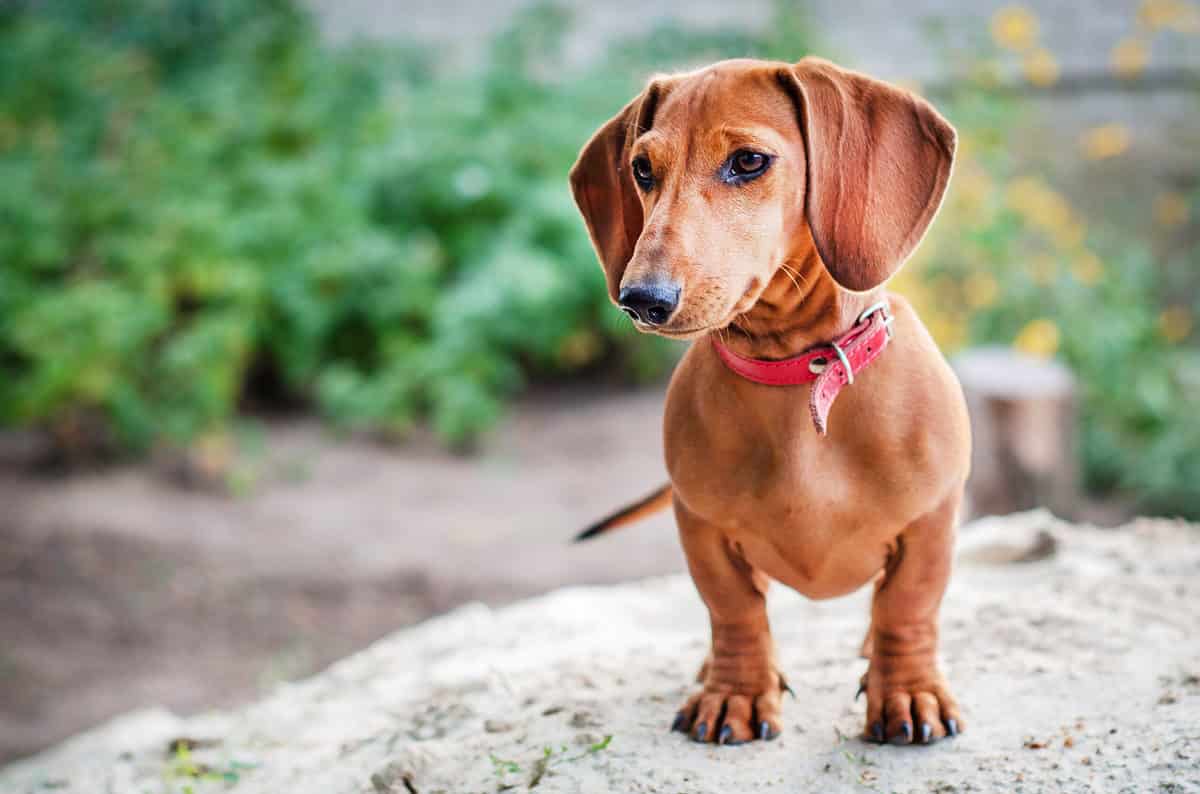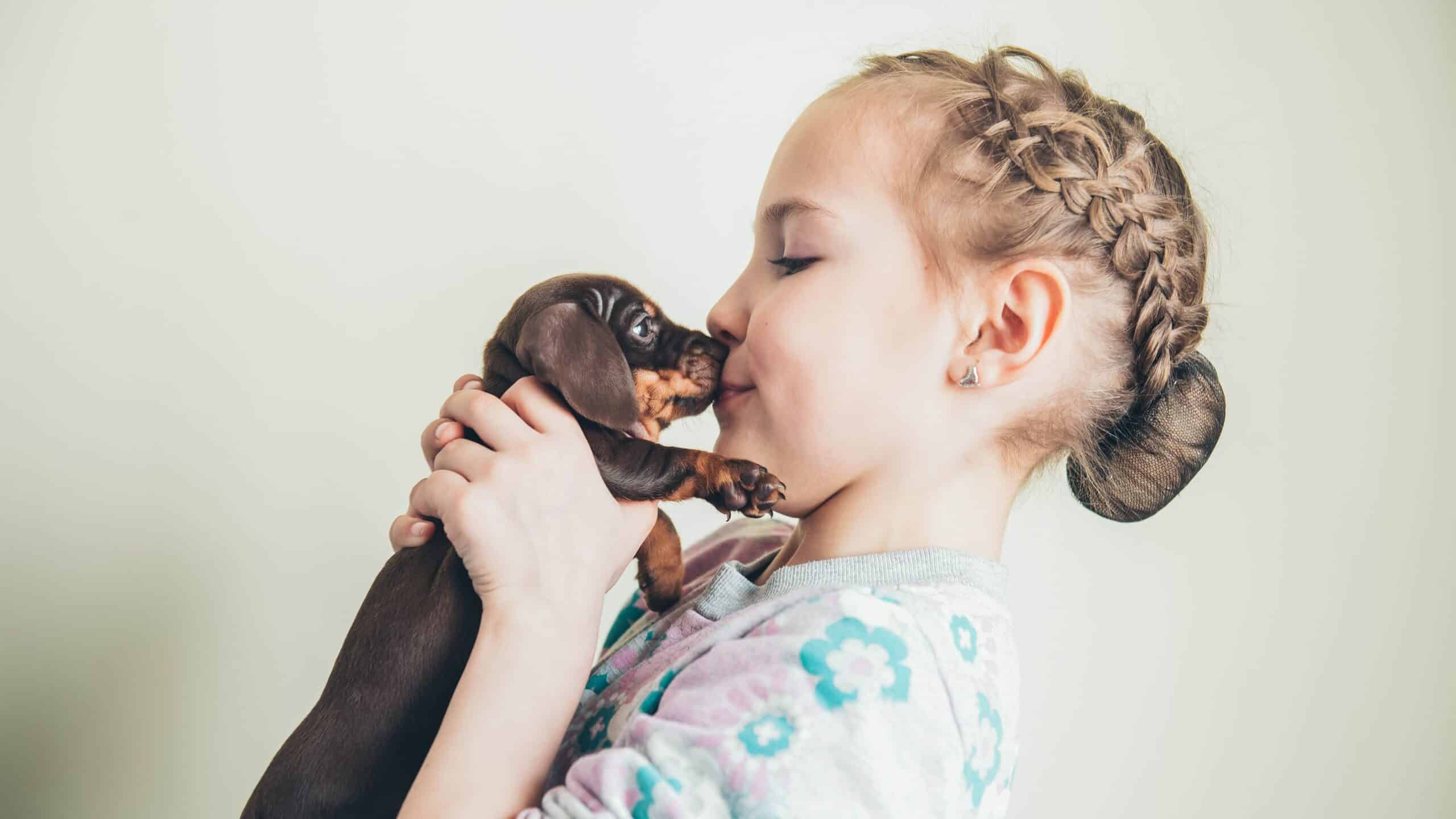The dachshund is the 12th most popular dog breed in the United States, and it is easy to see why. While this adorable breed was originally bred to find, chase, and hunt smaller animals like badgers and rabbits from gardens and private properties, it has since become a favorite pet of many animal lovers around the country. The question is, how is this breed around kids? Today, we will discuss this question and more with tips, advice, and suggestions for adding a dachshund to your home.
How Big Do Dachshunds Get?

©Olexandr Andreiko/Shutterstock.com
Dachshunds have a truly unique appearance with a lower profile and a longer body type. They are typically considered to be a small to medium-sized breed. A smaller (miniature) dachshund can be up to 8 inches tall at the shoulder, while the larger breed will reach 9 inches. As far as weight, most dachshunds will weigh between 16 to 32 pounds. Male and female breeds will be similar as far as height and weight.
How Much Energy Do Dachshunds Have?
Since they were originally bred to be hunters, dachshunds are a fairly energetic breed. Each dog can be different based on their size and personality, but they are not a lazy dog by any means. It has been found that the miniature dachshund can have a higher energy level compared to the standard dachshund.
Dachshunds typically fall in the middle of the spectrum when it comes to the energy levels of dogs. They will still require a moderate amount of exercise throughout the day. When you add a dachshund to your home, remember that they will require a daily walk. Also, playtime in the yard will do them well on a daily basis. However, dachshunds don’t typically get out of hand. In fact, they do well in both large houses and smaller apartment settings.
How to Train Dachshunds
The fact that dachshunds are relatively tame is good for training purposes. When it comes to training this breed, it is wise to start when they are puppies. They will typically be more receptive to new commands at a young age.
The key is to teach them simple commands like sit, come, stay, and heel. Once your dog starts to understand and follow the commands, make it a point to reward them with positive reinforcement via praise, treats, and affection. Under no circumstance should you express anger or scold a dachshund, or they could begin to fear you, and that will eliminate any chance of a future relationship.
In addition to the basic commands listed above, you will also want to spend some time potty training your dog. Make it a point to consistently bring them outside, show them the spot that they should go to for potty breaks, and give them affection or praise when they do it properly.
Consistency is key in the beginning. Train them every day until they start to understand your commands. Keep your sessions to 5-10 minutes because dachshunds can tend to have a short attention span.
Once you get the dachshund to your home, it is important that you get them out in public, as socialization is an important part of the training process. Take them for a walk around town or go to the dog park so they can see different people, places, and animals. This is the best way for them to get used to new surroundings, so they don’t get upset.
How Much Maintenance Do Dachshunds Require?
In general, dachshunds are typically a relatively low-maintenance breed. While they will need the regular exercise that most dogs require, they won’t completely change your regular routine.
Typical Maintenance Requirements
In addition to regular walks and exercise at the dog park or out in the yard, you will want to ensure that your dachshund is well-groomed. Their coat requires regular brushing to remove dead hair and maintain its nice shine. If you have a long-hair variety, then you will also want to trim their hair when necessary.
On top of the hair care, you will also want to make it a point to regularly trim their nails and brush their teeth and practice dental hygiene.
Healthcare and Common issues
If you bring a dachshund to your home, then you should know that while they are a generally healthy breed, some dachshunds may have common health conditions. Among them are:
- Canine cancer
- Seizures
- Heart problems
- Back problems
You may be able to determine if your dachshund is experiencing health problems if they are sluggish, hesitant to go upstairs, sensitive when you touch their back, restlessness, or have trouble walking.
In order to catch these issues early and get the proper treatment, make it a habit to bring your dog to the veterinarian on a regular basis. If your dog does have a health issue, advise your kids how to act around them, so they don’t cause additional pain or irritation.
How Much Does It Cost to Own a Dachshund?
The initial cost of a dachshund is typically around $500 to $2,000 for a puppy purchased from a reputable dealer. Of course, there are many factors to consider, including age, bloodline, location, breeder reputation, and breed (standard or miniature). If you are looking for the next level up, then you can also purchase a dachshund from a champion bloodline. In that case, you could spend upwards of $2,000 to $5,000 upfront.
You also have the option of buying a dachshund from a pet store. The cost can be substantially less, but you may get what you pay for. Sometimes, these dogs can have potential temperament or health issues. If you want to get the best dog for your family, then consider going with the dealer, as they will screen their dogs for potential issues. Also, these dogs are typically raised in a more loving environment.
Cost Over Time
Once you have your dachshund, you can expect to pay around $2,000 a year for all necessary expenses. Probably expenses include:
Food – Speciality breeds like dachshunds typically do better when they eat high-quality dog food, and that can cost you around $300 – $500 per year.
Healthcare – As far as visiting the vet is concerned, you can expect to pay what most dog owners pay, which is around $500 to $1,500 per year. That amount may increase if you experience unexpected emergencies.
Pet Insurance – You can mitigate the cost of veterinary visits and healthcare by investing in a good pet insurance policy. Most of these policies will cost between $300 and $900 per year, depending on the specifics of your case.
Miscellaneous Expenses – You can expect to spend some money on various other expenses like toys, grooming supplies, bedding, dishes, leashes, and more. If your dog requires professional training, you can expect to pay $100 to $300 for classes.
How Old Should Your Child Be When You Get a Dachshund?

©fizkes/Shutterstock.com
In general, most children 8 years old and above can handle the experience and responsibility of having a dachshund. It is at this age that they can understand what they should and should not do around the dog. They will also be able to help with some of the responsibilities of pet ownership at this time.
However, you need to consider the maturity level of your child. Some kids are mature enough to handle a dog at a younger age, while others may not be ready until later. Even if they are mature for their age, you should still be involved in the care of the dachshund. While your kids can put out the food and play in the backyard, adults should supervise the situation during walks and cleanup.
You also need to consider the overall lifestyle of your family. Although they are relatively low-maintenance, dachshunds still need plenty of love, care, and exercise. If you have a busy family or you work a lot, then it may not be time to bring an active pet into your home.
Are Allergies an Issue with Dachshunds?
Although most kids aren’t specifically allergic to dachshunds, there is a possibility that your child could be allergic. In most cases, these allergens are a reaction to the proteins found in the dog’s urine, skin cells, and saliva. If they are allergic, then you can expect sneezing, itchy eyes, skin irritation, and/or runny nose.
If your kid has a history of allergies or you think they may be allergic to kids in general, then it is a good idea to get them tested before bringing a dachshund to your home. An allergist can perform a skin or blood test.
In the case that your child has some allergies but they still really want a dachshund, then you can limit their negative reactions by regularly washing and grooming your dog. Also, frequent vacuuming and dusting can help. You should also make it a point to keep the dog out of your child’s room. Some over-the-counter medications may also do the trick.
General Tips and Precautionary Measures
In addition to the information shared above, there are several other tips and considerations you will want to make before you bring home a dachshund.
Protect Their Backs – Dachshunds have a unique appearance due to their long backs, and that is why one in four will experience Intervertebral Disc Disease. To protect their backs, make sure that they avoid going up and down the stairs or jumping off of furniture. It is also important to hold them properly by putting one hand under their front legs and one hand under their back legs.
Toxic Foods – Dachshunds should be kept away from certain foods that can be toxic to their system. Foods to avoid include chocolate, garlic, onions, raisins, avocado, macadamia nuts, and xylitol sweetener.
The First 12 Months – During the first year of a Dachshund’s life, they have a lot of growing to do, so it is important to let them take it easy. Stick to moderate exercise until their bones and muscles develop.
Proper Equipment
Before you bring the dachshund to your home, you should gather the items that will ensure their health and safety. Be sure to purchase the following:
- Playpen
- Body harness
- Puppy gates
- Bed
- Bowls for food and water
- Shampoo
- Puppy chews
- Leash
It is also important that you have a space for your dachshund to run and play. Ideally, you will have a backyard where they can get the exercise they require. If you don’t yet have one, install a fence to keep them safe.
Verdict: Are Dachshunds Good with Kids?
Yes, dachshunds are good for kids and you should add a dachshund to your home. This breed is the ideal small dog that can fit into almost any household. They have a lot of energy but not so much that they can get out of control. With that said, your kids still need to be mature enough to handle the responsibility of caring for the dog, so make those preparations before you bring this adorable fur ball into your home.
Up Next:
- Are Goldendoodles Good With Kids? What Parents Need To Know
- Are Newfoundlands Good With Kids? What Parents Need To Know
- Are Poodles Good With Kids? What Parents Need To Know
- Are Shih Tzus Good With Kids? What Parents Need To Know
- Are Corgis Good With Kids? What Parents Need To Know
- Are German Shepherds Good With Kids? What Parents Need To Know
- Are Dalmatians Good With Kids? What Parents Need To Know
- Are Dobermans Good With Kids? What Parents Need To Know
- Are Labs Good With Kids? What Parents Need To Know
- Are French Bulldogs Good With Kids? What Parents Need To Know
- Are Belgian Malinois Good With Kids? What Parents Need To Know
- Are Pitbulls Good With Kids? What Parents Need To Know
The image featured at the top of this post is ©Nigmatulina Aleksandra/Shutterstock.com.
